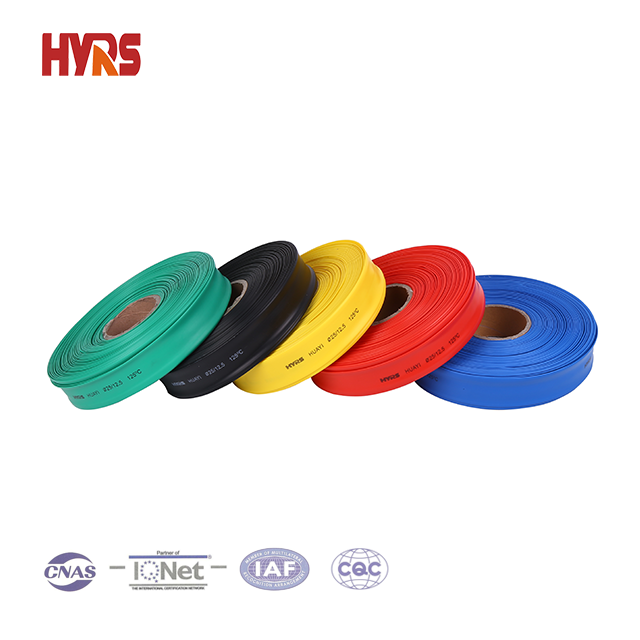Striking the Right Balance: Exploring Variations in Wall Thickness of Low Voltage Heat Shrinkable Tubes and Their Impact on Performance
2024-01-22
Introduction:
In the realm of electrical insulation, low voltage heat shrinkable tubes play a crucial role in protecting wires and cables. A key factor influencing their performance is the wall thickness of these tubes. In this blog post, we will delve into the variations in wall thickness and the impact it has on the functionality, durability, and effectiveness of these essential components in electrical systems.
1. Understanding Wall Thickness:
- Nominal Thickness: The wall thickness of a heat shrinkable tube refers to the thickness of the material in its unshrunk or nominal state. This thickness is specified by the manufacturer and is a critical parameter that influences the tube's performance characteristics.
- Variability: Variations in wall thickness exist across different types and sizes of heat shrinkable tubes, allowing users to choose the most suitable option for their specific applications.
2. Impact on Insulation Properties:
- Thicker Walls for Enhanced Insulation: Tubes with thicker walls generally provide enhanced insulation properties. Thicker insulation is advantageous in applications where higher levels of electrical insulation are required to prevent electrical leaks or short circuits.
- Applications: Thicker-walled tubes find use in critical applications such as electrical connections, splices, and terminations where robust insulation is paramount.
3. Mechanical Protection and Abrasion Resistance:
- Thicker Walls for Increased Protection: The wall thickness of heat shrinkable tubes contributes to their mechanical protection capabilities. Thicker walls offer increased resistance to abrasion, physical damage, and wear and tear.
- Applications: In environments where cables are subject to movement, vibration, or potential abrasion, thicker-walled tubes are preferred for providing a robust protective layer.
4. Flexibility and Conformity:
- Balancing Thickness and Flexibility: While thicker walls enhance insulation and protection, they may impact the flexibility and conformity of the tube. Striking the right balance between thickness and flexibility is crucial to ensure that the tube can conform to the shape of cables and components.
- Applications: Applications that require flexibility, such as cable bundling or intricate wiring systems, benefit from tubes with a balanced wall thickness that allows for both protection and flexibility.
5. Heat-Shrinking Performance:
- Uniform Shrinkage: The wall thickness can influence the heat-shrinking performance of the tube. Tubes with consistent and uniform wall thickness are more likely to shrink evenly, providing a snug fit around cables and wires.
- Applications: Even shrinkage is essential in applications where a uniform and tight fit is crucial, such as cable splicing or termination points.
6. Temperature Resistance:
- Thicker Walls for Higher Temperatures: Thicker-walled tubes often exhibit better resistance to higher temperatures. This is beneficial in applications where the tubes are exposed to elevated temperatures or where heat resistance is a critical requirement.
- Applications: Industries such as automotive or industrial settings, where cables may be subject to high temperatures, benefit from heat shrinkable tubes with thicker walls and enhanced temperature resistance.
7. Customization for Specific Applications:
- Tailored Solutions: Manufacturers may offer tubes with varying wall thickness options, allowing users to choose tubes that are tailored to the specific requirements of their applications.
- Applications: Customization is particularly relevant in industries with unique specifications, where the selection of tubes with specific wall thicknesses can address the specific challenges of the application.
8. Compliance with Standards:
- Adherence to Standards: Industry standards may specify certain requirements for wall thickness to ensure that tubes meet performance and safety criteria. Tubes conforming to these standards provide assurance of reliability and performance.
- Applications: Industries requiring compliance with standards, such as aerospace or telecommunications, benefit from tubes that adhere to specified wall thickness requirements.
Conclusion:
The wall thickness of low voltage heat shrinkable tubes is a critical factor that influences their insulation properties, mechanical protection capabilities, flexibility, and overall performance. Striking the right balance between thickness and flexibility is key to ensuring that these tubes effectively safeguard wires and cables in diverse electrical applications. As silent guardians in the intricate tapestry of electrical systems, the variations in wall thickness offer a spectrum of options, allowing users to tailor their choices for optimal performance in specific environments and applications.



